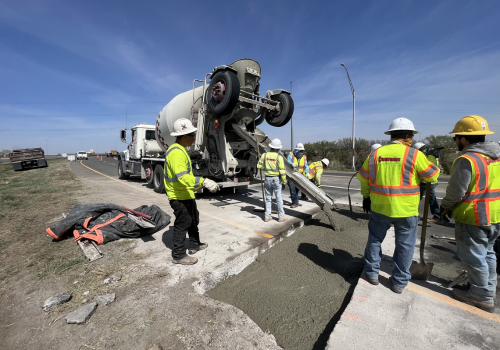 While distracted driving, speeding, and impaired driving play a big role in construction work zone accidents, as a construction worker you should also take steps to protect yourself. Hazards can change from minute to minute, so learn to recognize and control them for the safety of yourself and your crew., and ultimately follow the safe work rules and practices established by your employer. Brian Turmail, Vice President of Public Affairs & Strategic Initiatives at Associated General Contractors of America shares tips every on-road construction crew must know to keep themselves and their coworkers safe.
While distracted driving, speeding, and impaired driving play a big role in construction work zone accidents, as a construction worker you should also take steps to protect yourself. Hazards can change from minute to minute, so learn to recognize and control them for the safety of yourself and your crew., and ultimately follow the safe work rules and practices established by your employer. Brian Turmail, Vice President of Public Affairs & Strategic Initiatives at Associated General Contractors of America shares tips every on-road construction crew must know to keep themselves and their coworkers safe.
1. Wear the right PPE
The Occupational Safety and Health Association (OSHA) mandates the use of personal protection equipment in construction for good reason. PPE is the last defense between you and an accident when risk can’t be eliminated through engineering and other administrative controls. Hard hats, high visibility gear, gloves, work boots, and fall arrest systems can protect you from injury. Know what PPE is required for the job at hand and insist it is not only provided but that it fits properly. It’s also up to you to ensure that your PPE is in good condition and working properly. Check it daily for signs of wear.
2. Be aware
You’re especially at risk when working on foot on a highway construction site near moving vehicles and heavy equipment. The largest number of vehicle strikes don’t come from the traveling public but from contractor vehicles. Maintain constant awareness of your surroundings and always plan where you will run or jump to get out of the way.
Take care to avoid blind spots and remain in clear line of sight of coming traffic and other machinery. Workers near the edge of work zones should never turn their backs to oncoming traffic.
Heavy equipment operators should never move equipment without making visual contact with workers on foot near the equipment. Set parking brakes when leaving equipment unattended and chock wheels when equipment is parked on a slope.
Obtaining a basic orientation to the work site is essential to safety. It’s important to understand internal construction traffic flow, how vehicles are expected to enter and exit the work zone, emergency escape path designations, required PPE, and emergency signals for vehicle intrusions into the work area. This information could save your life.
AGC’s Highway Workers Safety Program includes important advice to guide workers: Before beginning any task ask yourself, “How can I do this without injury or accident?“ Educational materials are designed to assist in mitigating highway worker safety exposures by increasing awareness of the hazards and the appropriate control measures.
3. Protect yourself against severe weather
Severe weather can not only wreak havoc on a jobsite, it can put you in danger. From lightning strikes and flying debris to heat and cold exposure, workers need to be prepared for a wide range of hazards.
OSHA requires all employers to develop a written emergency action plan to protect their workers during any type of emergency, including bad weather. As a construction worker, you should know what this plan entails, including where to find emergency shelter, how to describe the work site location to emergency personnel, and who to contact in an emergency.
According to OSHA, workers should pay attention to early weather signs indicating potential lightning strikes, such as high winds, dark clouds, or distant thunder or lightning. If you hear thunder, immediately unplug electrical equipment or tools, put them away, and move to a safe place. By the time thunder is audible, it’s possible to be struck by lightning — even if it isn’t raining yet or there is no visible lightning. Seek safety in a building or hard-top vehicle with the windows rolled up. Avoid tall structures, open spaces conductive materials, and explosives. Remain sheltered for at least 30 minutes after hearing the last sound of thunder.
Both motorists and construction workers can help reduce work zone accidents, but more needs to be done, as safety is everyone’s responsibility. According to Turmail, Oklahoma recently acted to require a one-hour training class on Work Zone safety for all new drivers. In Washington state, contractors are now able to park decoy patrol cars with flashing lights in the work zone. AGC would like to see the same social stigma around speeding in the work zone as there is for drunk driving.
We need everyone to get home safely.
Read Next
Help Us Get Home Safe: Work Zone Safety Tips All Motorists Need to Know










